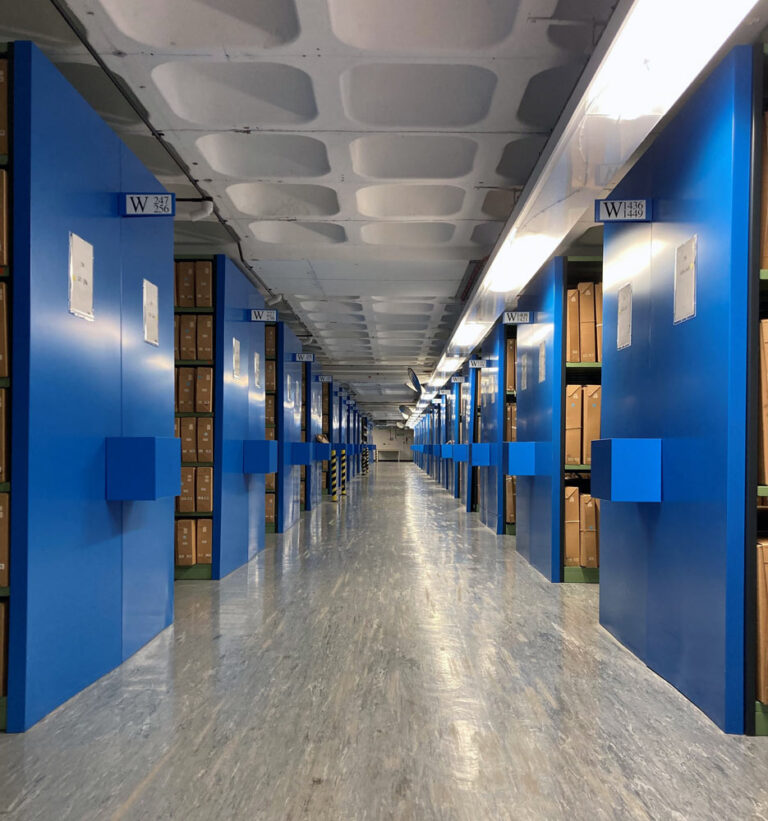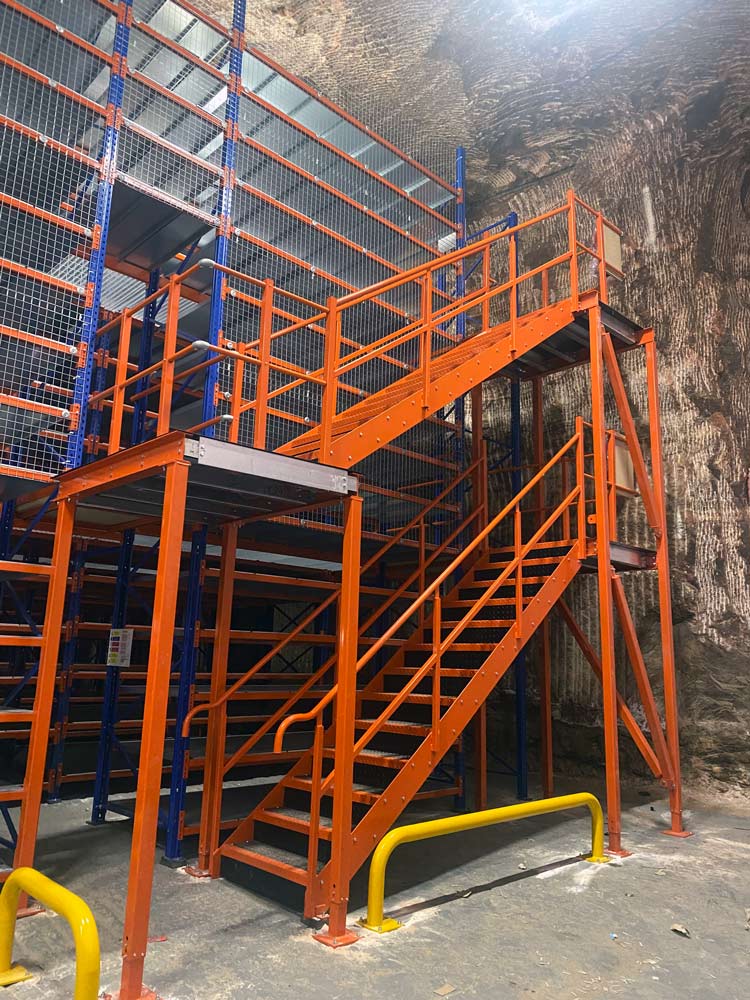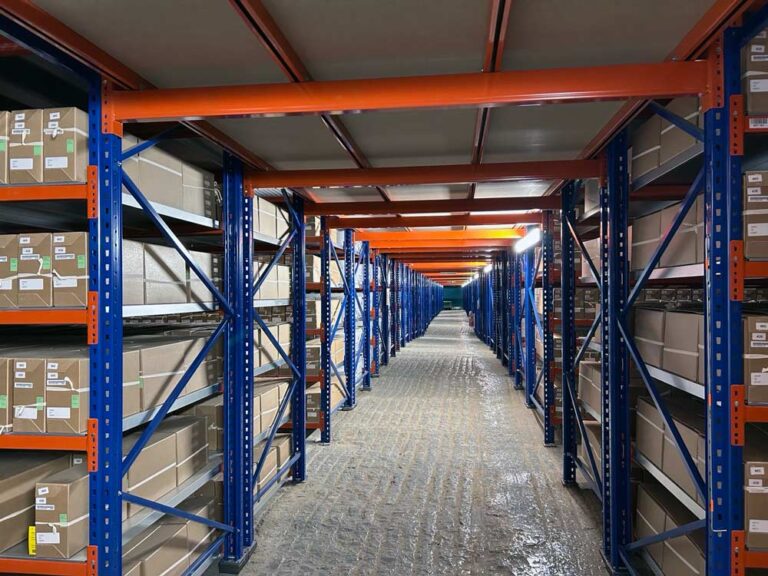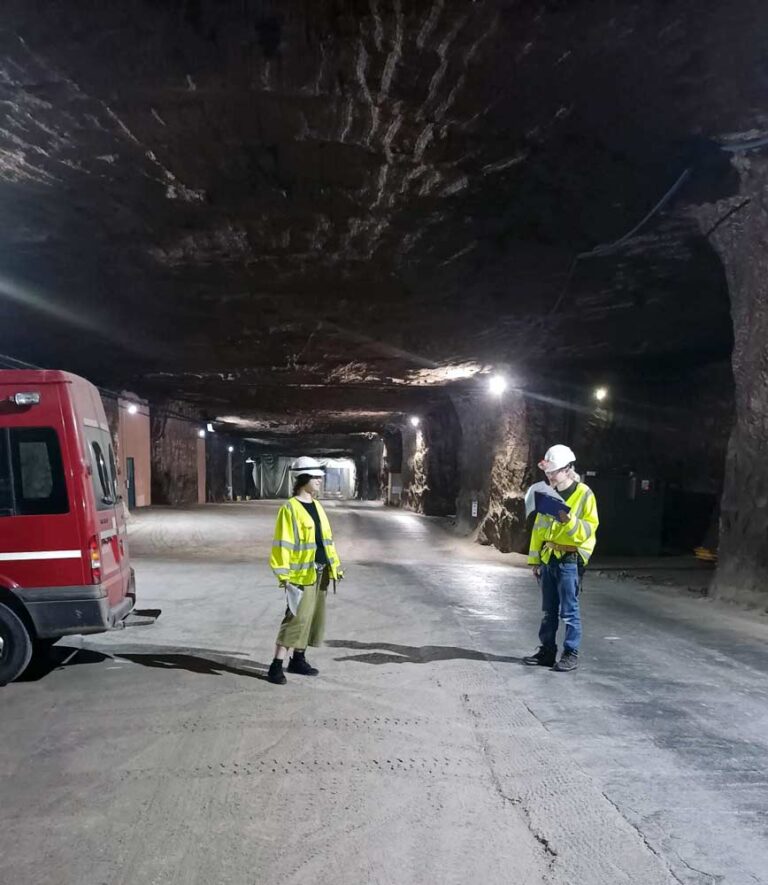For an operation as large as The National Archives, having enough storage space is a constant challenge. As well as our main site at Kew, London, we also use the offsite storage facility DeepStore, located at the Winsford salt mine in Cheshire. Found 150 metres below ground, the stable temperature and humidity conditions of the mine are ideal for storing records. DeepStore now holds about 30% of our documents.
Working in the team that transfers documents from Kew to Winsford, we wanted to explain how and why we move documents offsite to provide insight into our process.

Why we move documents offsite
At The National Archives we talk about shelving space in terms of metres, as each of our shelves are about one metre long. Our Kew premises contains eight repositories, holding 176 kilometres of storage between them. These repositories are all close to full and there is no scope to expand storage capacity at Kew.
As we are constantly taking in new records from government, we also use offsite storage at DeepStore. This allows us to expand our overall storage capacity by a further eight repositories, totalling 76 kilometres of shelving space.
Due to the distance from Winsford to Kew (some 185 miles) documents that are stored offsite must be ordered four working days in advance. This allows time for them to be transferred by lorry to Kew.
Readers may have noticed an increase in the number of documents listed as being offsite in recent years. This is because we have two projects currently running that require us to take in large numbers of new records onsite.
The first of these is the transfer from the Ministry of Defence of over 11.4 million Second World War service records, and the second is the move of the Parliamentary Archives from Westminster to The National Archives, about 6.8 kilometres of documents. These projects combined require about 23 kilometres of space, 13% of the overall space available to us at Kew.

How we choose what to move
Most items that have been digitised are sent to DeepStore. This allows us to better preserve the originals whilst still providing public access to the digitised copies. However, as less than 10% of our collection is digitised, we must also move documents that have not been digitised.
We choose these documents using a variety of criteria. These include the number of documents in a series (a group of records with a common function or subject, for example FO 371), whether there is a lot of variation in the sizes of boxes in a series, and whether the series will be closed for a long time. For example, due to the 100 year rule we have some documents that won’t be open until 2100! These are all considered, but the most important factor is usage.
The National Archives’ document ordering system shows us the number of times a document has been ordered going as far back as 1999. This allows us to determine which series are the most and least popular. Taking the number of orders, the length of the series and the number of different readers ordering from the series into account, we can select the least ordered series to send offsite.
By selectively sending these series, we can create space at Kew whilst minimising inconvenience to readers.

Why are some records not available to order?
When we prepare a document for transfer to DeepStore, we change the document’s status on our document ordering system to prevent it from being ordered by readers and staff. This allows us to ensure the full selection of documents that we wish to send is available to us.
Documents are then packaged onto pallets and taken to a holding area to await collection. Once the pallet is collected and driven to DeepStore the documents must be unloaded onto their shelves and their new locations recorded. The list of new locations is sent to the Archive Management Team twice a month, and we then update the locations on our document ordering system and remove the relocation condition, allowing documents to be ordered again.
The number of stages in this process means that it is usual for a document that is being moved offsite to be unavailable for about a month. Some larger series can require multiple collections and so will take longer to be made available, but we aim to have documents unavailable for no longer than six weeks.

Current moves figures
Many of our projects are fast moving, so the figures will be changing constantly in the coming months, but hopefully, this is an informative snapshot of what we’ve done so far.
This financial year so far, we have moved 5,639 metres of documents from Kew to DeepStore. We have also taken in about 1.5 kilometres of documents from government, in addition to the Ministry of Defence service records.
Last financial year (2023 to 2024), records held at DeepStore accounted for 3% of the 368,044 documents we produced to our public reading rooms.
We understand that it can be frustrating when documents aren’t readily available, and we appreciate the patience and understanding of our readers. We hope this provides some clarity about why some documents are temporarily unavailable or must be ordered in advance.
This is a fascinating and well written article. It’s helpful to see photos of the storage areas, as they give a sense of scale. Given the logistics of getting material from Deep Store to Kew, 4 days wait for documents seems reasonable.
I once toured DeepStore in connection with my work. The amount of powdered salt swirling round worried me, but no one seemed concerned. Even if all items are stored in some kind of enclosure, is the salt not a threat at all?
It’s safe thanks to a large filtering mechanism that removes any containments, including salt. There is also a managed airflow system throughout the mine.
I live in Cheshire and have to travel to Kew to see the records that are stored locally. It would make sense if there was a reading room in Winsford for us living in the north, saving transport costs and pollution.
Sorry, as DeepStore is a secure storage facility, it’s not possible for the public to visit at this time. Most of the records stored at DeepStore are either digitised and available online or of very low usage.
I presume this site is the old salt mines? It’s good to know that while some records are not available they are not lost forever. I just wonder how long before all records are on a digital base of some sort ?
I was interested to learn that the Archives make use of the salt mines in Cheshire. My daughter works at a Cheshire hospital, and they have the same arrangements. In this technical age, it might surprise some people, but I understand that deterioration can take place with scrolls and papers that hold vital and/or significant information. I remember that during WW2 a similar arrangement was undertaken. I was born in 1947, so after the end of the war, but my parents and grandparents told me about unusual events, such as the Royal Mint being relocated, and they also mentioned important items were kept in safety – I believe there were two main reasons for this. If the Germans invaded, they would not be able to locate these important items. Also, if the original place in which they had been kept was bombed, nothing would be lost after the items had been moved deep underground.
Well that is interesting and mind-boggling. has the DeepStore site have staff or do they just visit as and when needed?
Interesting insight. It’s frustrating though for those of us who live near Cheshire who would have to order four days in advance to then travel the 185 miles to view something which is usually next door! Is there no alternative?
Loved this piece, as we rarely think about the scale and logistics of storing such treasures. Thank you so much for sharing these details.
The photographs really brought this article to life. With such a large load to shelf, I wonder if anything gets lost or misplaced and, if so, how you manage or recover that problem.
I remember enquiring about a document a number of years ago. It had been digitised and then gone to Deepstore but some of the digitised information wasn’t legible. I was told I could request it (and given a form) but at the time I didn’t know when I’d next be able to get to Kew. All of this was before lockdown.
Can you advise if this is something you still do and what the lead time might be. I can then think about trying again.
Yes, if there is a problem with a digital copy, you can request to view the document in person using our make a records and research enquiry form. You’ll also need a reader’s ticket to visit our reading rooms.
Very interesting. The University of Minnesota Archives, in Minneapolis MN, are located under the Mississippi River and adjacent to the University. It’s a fascinating place to visit.
The vast size of this task is truly remarkable and your ability to organize it coherently is equally remarkable. Thank you for presenting it to the public. As an American, I wish NARA would present a comparable article. Thank you.
Great idea and insightful article: thank you!
Very interesting, well-written piece. I worked for a company in the USA, and we had some historic records stored in a limestone mine in western Pennsylvania. It was quite an experience to go ‘deep underground’ on an electric cart to find boxes of records on a pallet!
My experience of salt in the kitchen, is that it gathers and holds onto WATER.
From this, it would seem that an old salt mine would not be appropriate for paper documents. There must be something highly illogical in my thought process, so I should be grateful to be educated out of this viewpoint please. Thanks in advance.
It’s safe thanks to the air temperature being kept at 14 degrees and the managed humidity of around 55%. There are also ‘de-watering tunnels’ that remove excess moisture.
My previous employer also used DeepStore so it is of some interest to see what the facility looks like
Excellent article. Now that I know about the transfer processes and complexities I can fully appreciate why there is a delay producing some records and why others may be temporarily unavailable.
I wish more public bodies made this type of information available.